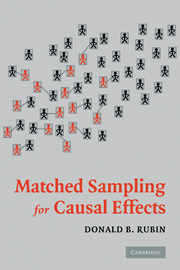Book contents
- Frontmatter
- Contents
- Contributor Acknowledgments
- Matched Sampling for Causal Effects
- My Introduction to Matched Sampling
- PART I THE EARLY YEARS AND THE INFLUENCE OF WILLIAM G. COCHRAN
- PART II UNIVARIATE MATCHING METHODS AND THE DANGERS OF REGRESSION ADJUSTMENT
- PART III BASIC THEORY OF MULTIVARIATE MATCHING
- 6 Multivariate Matching Methods That Are Equal Percent Bias Reducing, I: Some Examples
- 7 Multivariate Matching Methods That Are Equal Percent Bias Reducing, II: Maximums on Bias Reduction for Fixed Sample Sizes
- 8 Using Multivariate Matched Sampling and Regression Adjustment to Control Bias in Observational Studies
- 9 Bias Reduction Using Mahalanobis-Metric Matching
- PART IV FUNDAMENTALS OF PROPENSITY SCORE MATCHING
- PART V AFFINELY INVARIANT MATCHING METHODS WITH ELLIPSOIDALLY SYMMETRIC DISTRIBUTIONS, THEORY AND METHODOLOGY
- PART VI SOME APPLIED CONTRIBUTIONS
- PART VII SOME FOCUSED APPLICATIONS
- Conclusion: Advice to the Investigator
- References
- Author Index
- Subject Index
8 - Using Multivariate Matched Sampling and Regression Adjustment to Control Bias in Observational Studies
Published online by Cambridge University Press: 05 June 2012
- Frontmatter
- Contents
- Contributor Acknowledgments
- Matched Sampling for Causal Effects
- My Introduction to Matched Sampling
- PART I THE EARLY YEARS AND THE INFLUENCE OF WILLIAM G. COCHRAN
- PART II UNIVARIATE MATCHING METHODS AND THE DANGERS OF REGRESSION ADJUSTMENT
- PART III BASIC THEORY OF MULTIVARIATE MATCHING
- 6 Multivariate Matching Methods That Are Equal Percent Bias Reducing, I: Some Examples
- 7 Multivariate Matching Methods That Are Equal Percent Bias Reducing, II: Maximums on Bias Reduction for Fixed Sample Sizes
- 8 Using Multivariate Matched Sampling and Regression Adjustment to Control Bias in Observational Studies
- 9 Bias Reduction Using Mahalanobis-Metric Matching
- PART IV FUNDAMENTALS OF PROPENSITY SCORE MATCHING
- PART V AFFINELY INVARIANT MATCHING METHODS WITH ELLIPSOIDALLY SYMMETRIC DISTRIBUTIONS, THEORY AND METHODOLOGY
- PART VI SOME APPLIED CONTRIBUTIONS
- PART VII SOME FOCUSED APPLICATIONS
- Conclusion: Advice to the Investigator
- References
- Author Index
- Subject Index
Summary
Abstract: Monte Carlo methods are used to study the efficacy of multivariate matched sampling and regression adjustment for controlling bias due to specific matching variables X when dependent variables are moderately nonlinear in X. The general conclusion is that nearest available Mahalanobis metric matching in combination with regression adjustment on matched pair differences is a highly effective plan for controlling bias due to X.
INTRODUCTION
Our objective is to study the utility of matched sampling and regression adjustment (covariance adjustment) for controlling specific matching variables in observational studies. This introduction is brief; we assume that the reader is familiar with the literature on matching and covariance adjustment in observational studies (e.g., Althauser and Rubin 1970; Billewicz 1964, 1965; Campbell and Erlebacher 1970; Cochran 1953a, 1968; Cochran and Rubin 1973; Gilbert, Light, and Mosteller 1975; Greenberg 1953; Lord 1960; McKinlay 1974, 1975a, b; and Rubin 1974, 1977a, 1978a). In particular, this work is a natural extension of earlier Monte Carlo work on one matching variable (Rubin 1973a, b) and theoretical work on multivariate matching methods (Rubin 1976b, c.)
Matched sampling refers to the selection of treatment units (e.g., smokers) and control units (e.g., nonsmokers) that have similar values of matching variables, X (e.g., age, weight), whereas regression adjustment refers to a statistical procedure that adjusts estimates of the treatment effects by estimating the relationship between the dependent variable Y (e.g., blood pressure) and X in each treatment group.
Information
- Type
- Chapter
- Information
- Matched Sampling for Causal Effects , pp. 142 - 159Publisher: Cambridge University PressPrint publication year: 2006
